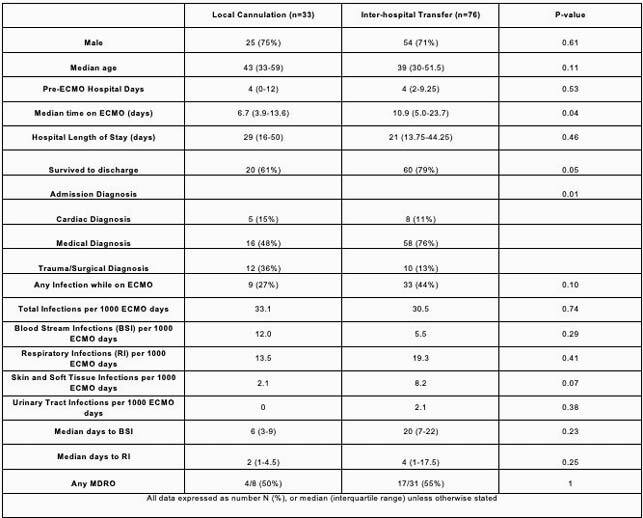Abstract
Background
Extracorporeal Oxygenation (ECMO) has been increasingly used as a life support modality for cardiac and pulmonary failure. Due to improved survival in patients treated in high volume ECMO centers, inter-hospital transport of these critically ill patients is on the rise. These patients may be transported via ambulance locally, or by aircraft over long distances. However, potential risks of nosocomial infectious complications associated with transfers has not been reported. We evaluated the impact of transfers on nosocomial infections for patients who received ECMO at Brooke Army Medical Center (BAMC).
Methods
All patients who received ECMO for ≥48 hours at BAMC between May 2012 and October 2019 were included. Chart review was performed to determine transport status, infectious complications while on ECMO, and antimicrobial susceptibility of isolated organisms. Statistical analyses were performed using Chi-squared, Fisher’s exact, or Mann-Whitney U tests as appropriate. Factors associated with nosocomial infections were evaluated by multivariate logistic regression.
Results
Compared to patients who were cannulated locally (n=33), patients who underwent cannulation at referral facility and inter-hospital transfer (n=76) had no difference in infections per 1000 ECMO days (33.1 vs. 30.5, p=0.74) or in infections with multidrug resistant organisms (MDRO) (50% vs. 55%, p=1). Of transferred patients, those transferred by aircraft (n=11) had no difference in infection rate (22.4 vs. 31.8 per 1000 ECMO days, p= 0.39) or MDRO incidence (52% vs 75%, p=0.61) compared to those only transferred by ambulance (n=65). Multivariate analysis showed the greatest risk factor for nosocomial infection was time on ECMO (OR 12.2 for longest tertile time on ECMO vs. shortest tertile, p=0.0001); transport was not significantly associated with infection (OR 2.1, p=0.06).
Nosocomial infection rate by site of ECMO cannulation

Conclusion
This study did not find a significant difference in nosocomial infection rate or recovery of MDROs between transported and non-transported patients on ECMO, regardless of transport modality. This study suggests that transportation is not the primary driver of nosocomial infections in this cohort.
Disclosures
All Authors: No reported disclosures


